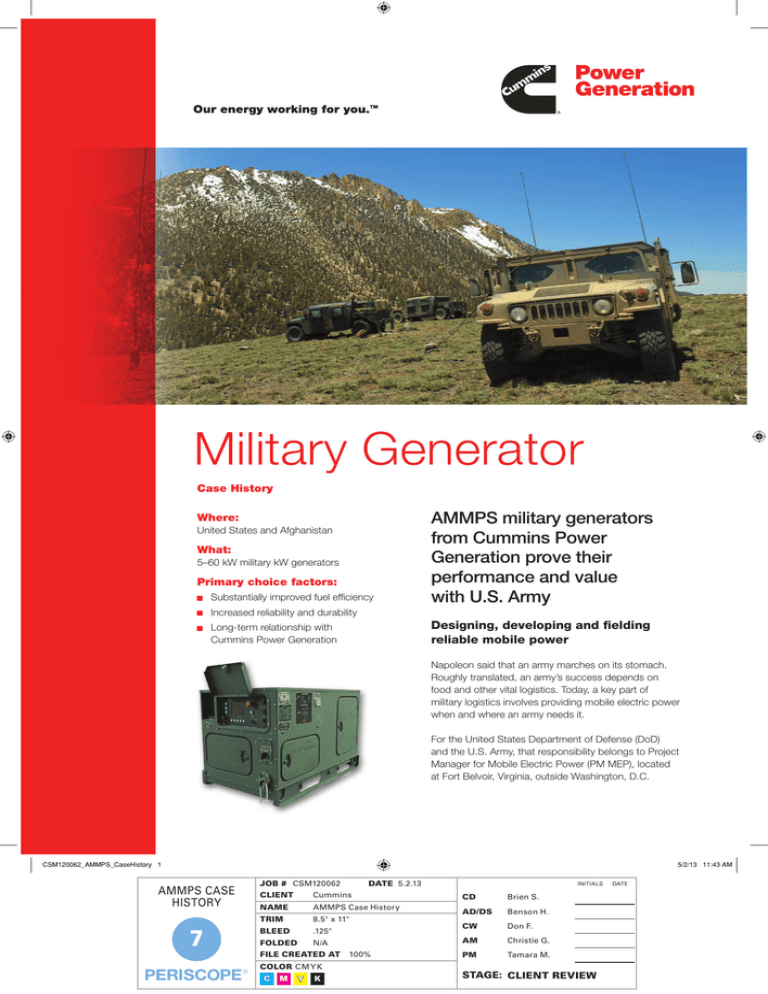
Military Generator
Case History
Where:
United States and Afghanistan
What:
5–60 kW military kW generators
Primary choice factors:
Substantially improved fuel efficiency
AMMPS military generators
from Cummins Power
Generation prove their
performance and value
with U.S. Army
Increased reliability and durability
Designing, developing and fielding
reliable mobile power
Long-term relationship with
Cummins Power Generation
Napoleon said that an army marches on its stomach.
Roughly translated, an army’s success depends on
food and other vital logistics. Today, a key part of
military logistics involves providing mobile electric power
when and where an army needs it.
For the United States Department of Defense (DoD)
and the U.S. Army, that responsibility belongs to Project
Manager for Mobile Electric Power (PM MEP), located
at Fort Belvoir, Virginia, outside Washington, D.C.
CSM120062_AMMPS_CaseHistory 1
5/2/13 11:43 AM
AMMPS CASE
HISTORY
7
JOB # CSM120062
DATE 5.2.13
CLIENT
Cummins
NAME
AMMPS Case History
TRIM
8.5" x 11"
BLEED
.125"
FOLDED
N/A
FILE CREATED AT
COLOR C M Y K
C
M
Y
K
100%
INITIALS
CD
Brien S.
AD/DS
Benson H.
CW
Don F.
AM
Christie G.
PM
Tamara M.
STAGE: CLIENT REVIEW
DATE
The mission of PM MEP is to establish, maintain and
provide a DoD standard family of mobile electric power
generating sources, in addition to developing the
best mobile generators for the military. PM MEP also
provides advice and consultation on how to improve
and expand the standardization of these power sources
across the armed forces.
PM MEP recently developed and deployed operational
energy solutions to our nation’s warfighting
commanders in Afghanistan, including the Advanced
Medium Mobile Power Sources (AMMPS) generators
from Cummins Power Generation. This case history tells
the story of how AMMPS generators came about.
Increasing needs, demanding criteria
Unlike Napoleon’s forces, today’s U.S. Army relies on
mobile electric power. Power is the lifeblood of the
networked systems that modern soldiers rely on to
communicate critical information across the battlefield.
As those systems multiply in number and capability,
the demand for power follows, increasing the need
for more efficient ways of generating, storing and
distributing energy.
In 2003, the U.S. Army recognized a need to replace
its Tactical Quiet Generator (TQG), which had been in
service since 1993, as well as some older MIL-STD
generators still in use. The Army wanted a new range of
more efficient generators from 5–60 kW that would be
significantly better than the existing units. Specifically
the criteria for the replacement generators were:
Enhanced power generation capability
Improved fuel efficiency
Increased system reliability
Reduced system size and weight
Increased survivability for military applications
Reduced total cost of ownership
Competitive bidding process
To realize these ambitious goals, the Army set up a
competitive bidding process with multiple phases.
In Phase 0 the Army sent out requests for proposals
(RFPs). Phase 0 was open to all manufacturers, and
several companies submitted proposals. Of those
companies, Cummins Power Generation and one other
bidder were selected to perform Phase I — Building
and Testing Prototypes.
Phase 0
Phase 0: Request for Proposals
Solicitation
Contractors Submit Proposals
Formal Source Selection Process
Phase I
Phase I: Award to up to Three Contractors
2003
“Cost-Plus”
Prototypes
and Testing
Build Prototypes
Prototype Testing
Test Reports
Evaluation Process
Phase II
Phase II: Exercise Option to Single Contractor
FY05–FY06
“Cost-Plus”
Pre-Production
Units and Testing
Pre-Production Unit Build
PPQT (Pre-Production Qualification Tests)
Test Reports
Phase III
Phase III: Exercise Option
“Fixed Price”
Production
FY08–FY11
First Production Deliveries
FUE
(First Unit Equipped)
FY11
FY11
After completion of Phase I, the Army selected
Cummins Power Generation to continue to Phase II,
based on the successful testing of 10 AMMPS
prototype units. Phase II included building and testing
130 pre-production units. The main factors for selecting
Cummins Power Generation were the successful
completion of Phase I, as well as proven design and
production capabilities.
Bob Lewis, AMMPS Program Manager for Cummins
Power Generation, said, “We designed the AMMPS
from the ground up as a rugged military generator.
We did not take a standard commercial generator and
simply try to adapt it for military use.”
The new generators would be known as AMMPS.
Photo credit: U.S. Army.
Two AMMPS units mounted on a trailer. Paralleling them is easy.
CSM120062_AMMPS_CaseHistory 2
5/2/13 11:43 AM
Phase III, the final phase, involves mass production,
and in July 2011 Cummins Power Generation received
the go-ahead to proceed with Full Rate Production.
AMMPS units have been delivered to military bases
around the U.S., where troops are being trained in their
operation, and PM MEP is deploying up to 379 of the
units to Afghanistan.
The AMMPS units are also able to operate in high or
low ambient temperatures and at high altitudes, and
have enhanced capabilities to survive nuclear, biological
and chemical (NBC) attacks, as well as infrared, aural,
and electromagnetic pulse (EMP) attacks. They can
also be dropped out of planes by parachute into
targeted locations.
Ease of operation. In addition, they can be
“organically supported.” That’s military-speak for
the ability of trained soldiers to operate and maintain
the generators, which also reduces total cost of
ownership. The custom-designed Digital Control
Station contributes to simplicity of operation; it offers
automatic paralleling and provides an easy-to-read
6.5-inch LCD display.
Parts commonality. Another cost-reducing advantage
is the use of the same parts across the product line.
The Digital Control Station is the same across all units,
and overall there is 52% parts commonality.
Photo credit: U.S. Army.
AMMPS units being readied for fielding to Afghanistan.
Reduced emissions. The AMMPS generator
engines are EPA-certified and can run on either
diesel or JP-8 fuel.
The AMMPS advantages
What’s next?
AMMPS generators are delivering a number of
important advantages that increase reliability and
reduce total cost of ownership for the DoD and
the U.S. Army.
The honored Cummins tradition of service to the military
builds on a 70-year legacy extending all the way back
to World War II. Onan Corporation — now part of
Cummins — was the leading supplier of generator sets
to U.S. and Allied forces, and Cummins Inc. supplied
engines for military vehicles and generators. Today
AMMPS units are being deployed where they can
benefit troops on active duty in Afghanistan.
Reduced size and increased fuel efficiency. Across
the product line, AMMPS generators are 10% smaller
and lighter than their TQG counterparts, offering greater
battlefield mobility. They are also 21% more
fuel-efficient.
This efficiency saves lives as well as dollars, by reducing
the number of fuel supply trips through hostile territory.
As MG Price noted, “The most important factor [in
the selection of military generators] is the number of
soldiers who will not be placed in harm’s way having to
transport fuel.”
Rugged reliability. Another key advantage: AMMPS
units are 50% more reliable than their predecessors.
Part of the reliability comes from a system design that
eliminates “wet stacking,” a common problem with
diesel generators in which unburned fuel passes into
the exhaust system.
CSM120062_AMMPS_CaseHistory 3
U.S. Army troops in Afghanistan receiving training on a
trailer-mounted AMMPS unit.
5/2/13 11:43 AM
The current DoD contract with Cummins Power
Generation runs through September 2014, and
planners for the armed services anticipate that AMMPS
systems will be procured through 2022. As befits our
heritage, Cummins Power Generation is committed to
continuing to help the DoD achieve its energy goals
now and in the future by providing reliable, fuel-efficient
power to our military.
The honored Cummins tradition of service
to the military builds on a 70-year legacy
extending all the way back to World War II.
Onan Corporation — now part of Cummins —
was the leading supplier of generator sets
to U.S. and Allied forces, and Cummins Inc.
supplied engines for military vehicles. Today
AMMPS units are being deployed where
they can benefit troops on active duty
in Afghanistan.
Cummins Power Generation Inc.
1400 73rd Ave. NE
Minneapolis, MN 55432 USA
www.cumminsonan.com
Phone 1 763 574 5000
Toll-free 1 800 888 6626
Fax 1 763 574 5298
Cleared for public exhibition only — no official U.S. Army endorsement is implied.
©2013 Cummins Power Generation. All rights reserved. Cummins, Onan and the “C” logo are registered trademarks
of Cummins Inc. “Our energy working for you.TM” is a trademark of Cummins Power Generation.
CSM120062_AMMPS_CaseHistory 4
NACH-5685-EN (5/13)
5/2/13 11:43 AM

